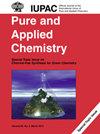石墨烯和氧化石墨烯的纳米复合纳米纤维膜:水污染修复潜力
IF 2
4区 化学
Q3 CHEMISTRY, MULTIDISCIPLINARY
引用次数: 0
摘要
对石墨烯或氧化石墨烯的大量研究工作导致形成了独特的纳米碳衍生纳米材料。石墨烯和氧化石墨烯在聚合物基质中得到增强,形成了高性能纳米复合材料。含有石墨烯或氧化石墨烯的聚合物纳米复合材料在纳米纤维的形成和随后的膜方面有着重要的应用经验。本概述重点介绍了石墨烯或氧化石墨烯衍生纳米复合纳米纤维膜的设计、基本特征和潜力,这些纳米纤维膜可用于水污染修复、污染物、盐类、毒素、微生物的渗透以及其他分离目的。在这里,聚合物填充的石墨烯或氧化石墨烯纳米复合材料通过适当的技术(如电纺丝、湿法纺丝、模板法等)加工成纳米纤维。然后,采用适当的技术,如溶液处理法、铸造法、浸润法等,将聚合物/石墨烯和聚合物/氧化石墨烯纳米纤维纳米复合材料用于形成纳米复合膜。因此,高性能膜已被研究用于技术目的,特别是水管理能力。未来对聚合物/石墨烯纳米纤维膜的研究可能会开发出用于商业和工业用途的高效系统。本文章由计算机程序翻译,如有差异,请以英文原文为准。
Nanocomposite nanofibrous membranes of graphene and graphene oxide: water remediation potential
Immense research efforts on graphene or graphene oxide have led to the formation of unique nanocarbon derived nanomaterials. Graphene and graphene oxide have been reinforced in polymeric matrices to form high performance nanocomposites. Significant applications of polymer nanocomposites with graphene or graphene oxide were experiential for nanofiber formation and ensuing membranes. This overview highlights design, essential features, and potential of graphene or graphene oxide derived nanocomposite nanofibrous membranes for water remediation permeation towards contaminates, salts, toxins, microbials, and other separation purposes. Here, polymer filled graphene or graphene oxide nanocomposites have been processed into nanofibers using appropriate techniques such as electrospinning, wet spinning, template method, etc. Afterwards, polymer/graphene and polymer/graphene oxide nanofiber nanocomposites were applied to form the nanocomposite membranes using appropriate techniques like solution processing, casting methods, infiltration, etc. Consequently, high performance membranes have been researched for technological purposes, especially water management competence. Future research on polymer/graphene nanofibrous membranes may lead to highly efficient systems for commercial and industrial level uses.
求助全文
通过发布文献求助,成功后即可免费获取论文全文。
去求助
来源期刊

Pure and Applied Chemistry
化学-化学综合
CiteScore
4.00
自引率
0.00%
发文量
60
审稿时长
3-8 weeks
期刊介绍:
Pure and Applied Chemistry is the official monthly Journal of IUPAC, with responsibility for publishing works arising from those international scientific events and projects that are sponsored and undertaken by the Union. The policy is to publish highly topical and credible works at the forefront of all aspects of pure and applied chemistry, and the attendant goal is to promote widespread acceptance of the Journal as an authoritative and indispensable holding in academic and institutional libraries.
 求助内容:
求助内容: 应助结果提醒方式:
应助结果提醒方式:


